Communication Plan for Professional Audience: ABS107 Report
VerifiedAdded on 2023/06/17
|6
|1393
|485
Report
AI Summary
This document presents a communication plan developed for a medium-sized firm that has recently acquired a large client and needs to inform its 200 employees about the expansion of its product line. The plan employs the organizational information theory to streamline communication and reduce ambiguity, focusing on delivering essential information effectively. It incorporates the Onion model of communication management, addressing the company's culture, sender-receiver dynamics, and message delivery. The plan considers various communication factors such as cultural diversity and competition, recommending downward communication from employers to employees. It suggests using social intranet software for private information sharing and outlines methods for measuring the presentation's success, such as observing the quality of discussions and employee performance. Final recommendations include choosing the right communication channel, considering the audience, encouraging two-way communication, and maintaining a positive tone and body language. The document includes references to support its strategies.
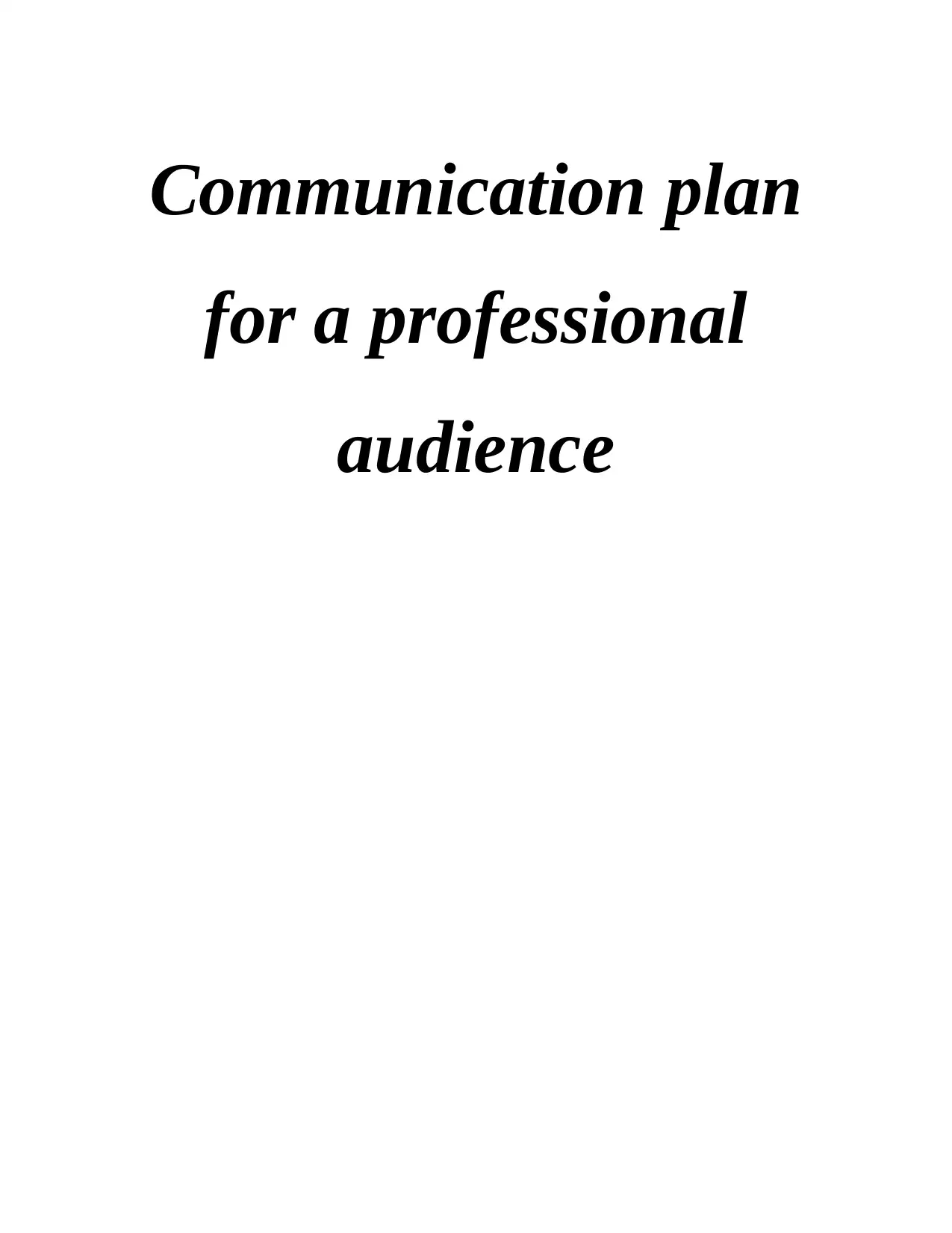
Communication plan
for a professional
audience
for a professional
audience
Paraphrase This Document
Need a fresh take? Get an instant paraphrase of this document with our AI Paraphraser
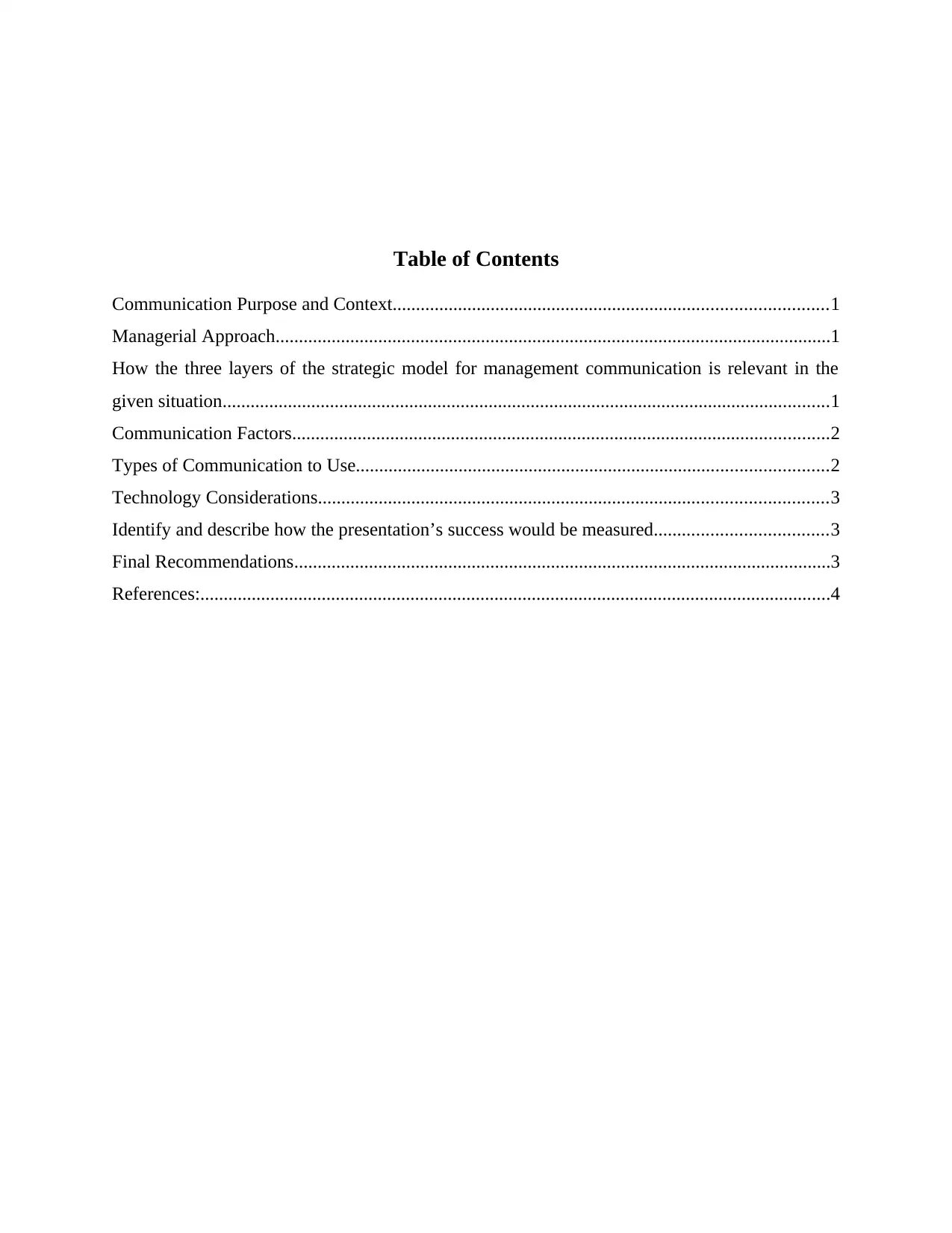
Table of Contents
Communication Purpose and Context.............................................................................................1
Managerial Approach.......................................................................................................................1
How the three layers of the strategic model for management communication is relevant in the
given situation..................................................................................................................................1
Communication Factors...................................................................................................................2
Types of Communication to Use.....................................................................................................2
Technology Considerations.............................................................................................................3
Identify and describe how the presentation’s success would be measured.....................................3
Final Recommendations...................................................................................................................3
References:.......................................................................................................................................4
Communication Purpose and Context.............................................................................................1
Managerial Approach.......................................................................................................................1
How the three layers of the strategic model for management communication is relevant in the
given situation..................................................................................................................................1
Communication Factors...................................................................................................................2
Types of Communication to Use.....................................................................................................2
Technology Considerations.............................................................................................................3
Identify and describe how the presentation’s success would be measured.....................................3
Final Recommendations...................................................................................................................3
References:.......................................................................................................................................4
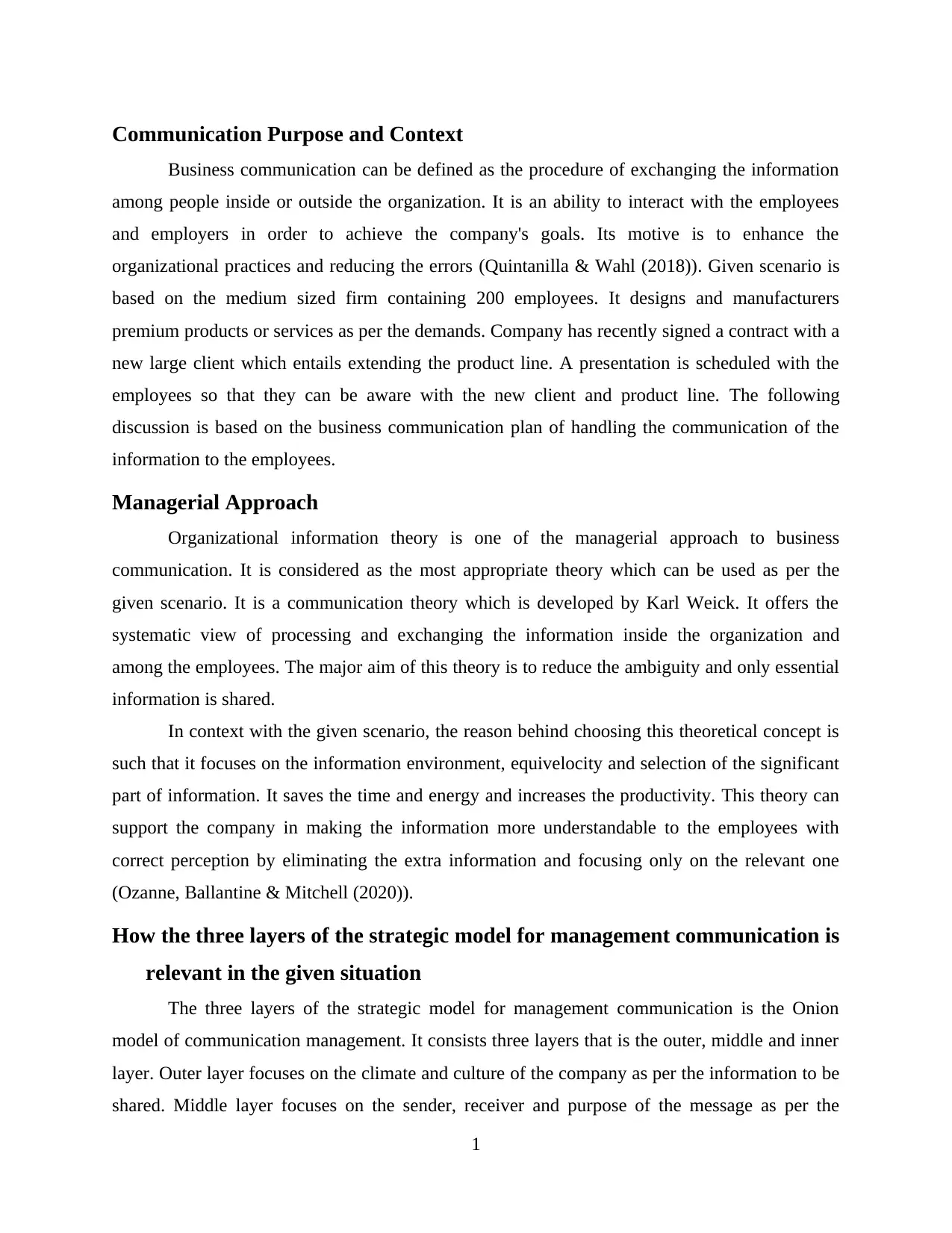
Communication Purpose and Context
Business communication can be defined as the procedure of exchanging the information
among people inside or outside the organization. It is an ability to interact with the employees
and employers in order to achieve the company's goals. Its motive is to enhance the
organizational practices and reducing the errors (Quintanilla & Wahl (2018)). Given scenario is
based on the medium sized firm containing 200 employees. It designs and manufacturers
premium products or services as per the demands. Company has recently signed a contract with a
new large client which entails extending the product line. A presentation is scheduled with the
employees so that they can be aware with the new client and product line. The following
discussion is based on the business communication plan of handling the communication of the
information to the employees.
Managerial Approach
Organizational information theory is one of the managerial approach to business
communication. It is considered as the most appropriate theory which can be used as per the
given scenario. It is a communication theory which is developed by Karl Weick. It offers the
systematic view of processing and exchanging the information inside the organization and
among the employees. The major aim of this theory is to reduce the ambiguity and only essential
information is shared.
In context with the given scenario, the reason behind choosing this theoretical concept is
such that it focuses on the information environment, equivelocity and selection of the significant
part of information. It saves the time and energy and increases the productivity. This theory can
support the company in making the information more understandable to the employees with
correct perception by eliminating the extra information and focusing only on the relevant one
(Ozanne, Ballantine & Mitchell (2020)).
How the three layers of the strategic model for management communication is
relevant in the given situation
The three layers of the strategic model for management communication is the Onion
model of communication management. It consists three layers that is the outer, middle and inner
layer. Outer layer focuses on the climate and culture of the company as per the information to be
shared. Middle layer focuses on the sender, receiver and purpose of the message as per the
1
Business communication can be defined as the procedure of exchanging the information
among people inside or outside the organization. It is an ability to interact with the employees
and employers in order to achieve the company's goals. Its motive is to enhance the
organizational practices and reducing the errors (Quintanilla & Wahl (2018)). Given scenario is
based on the medium sized firm containing 200 employees. It designs and manufacturers
premium products or services as per the demands. Company has recently signed a contract with a
new large client which entails extending the product line. A presentation is scheduled with the
employees so that they can be aware with the new client and product line. The following
discussion is based on the business communication plan of handling the communication of the
information to the employees.
Managerial Approach
Organizational information theory is one of the managerial approach to business
communication. It is considered as the most appropriate theory which can be used as per the
given scenario. It is a communication theory which is developed by Karl Weick. It offers the
systematic view of processing and exchanging the information inside the organization and
among the employees. The major aim of this theory is to reduce the ambiguity and only essential
information is shared.
In context with the given scenario, the reason behind choosing this theoretical concept is
such that it focuses on the information environment, equivelocity and selection of the significant
part of information. It saves the time and energy and increases the productivity. This theory can
support the company in making the information more understandable to the employees with
correct perception by eliminating the extra information and focusing only on the relevant one
(Ozanne, Ballantine & Mitchell (2020)).
How the three layers of the strategic model for management communication is
relevant in the given situation
The three layers of the strategic model for management communication is the Onion
model of communication management. It consists three layers that is the outer, middle and inner
layer. Outer layer focuses on the climate and culture of the company as per the information to be
shared. Middle layer focuses on the sender, receiver and purpose of the message as per the
1
⊘ This is a preview!⊘
Do you want full access?
Subscribe today to unlock all pages.

Trusted by 1+ million students worldwide
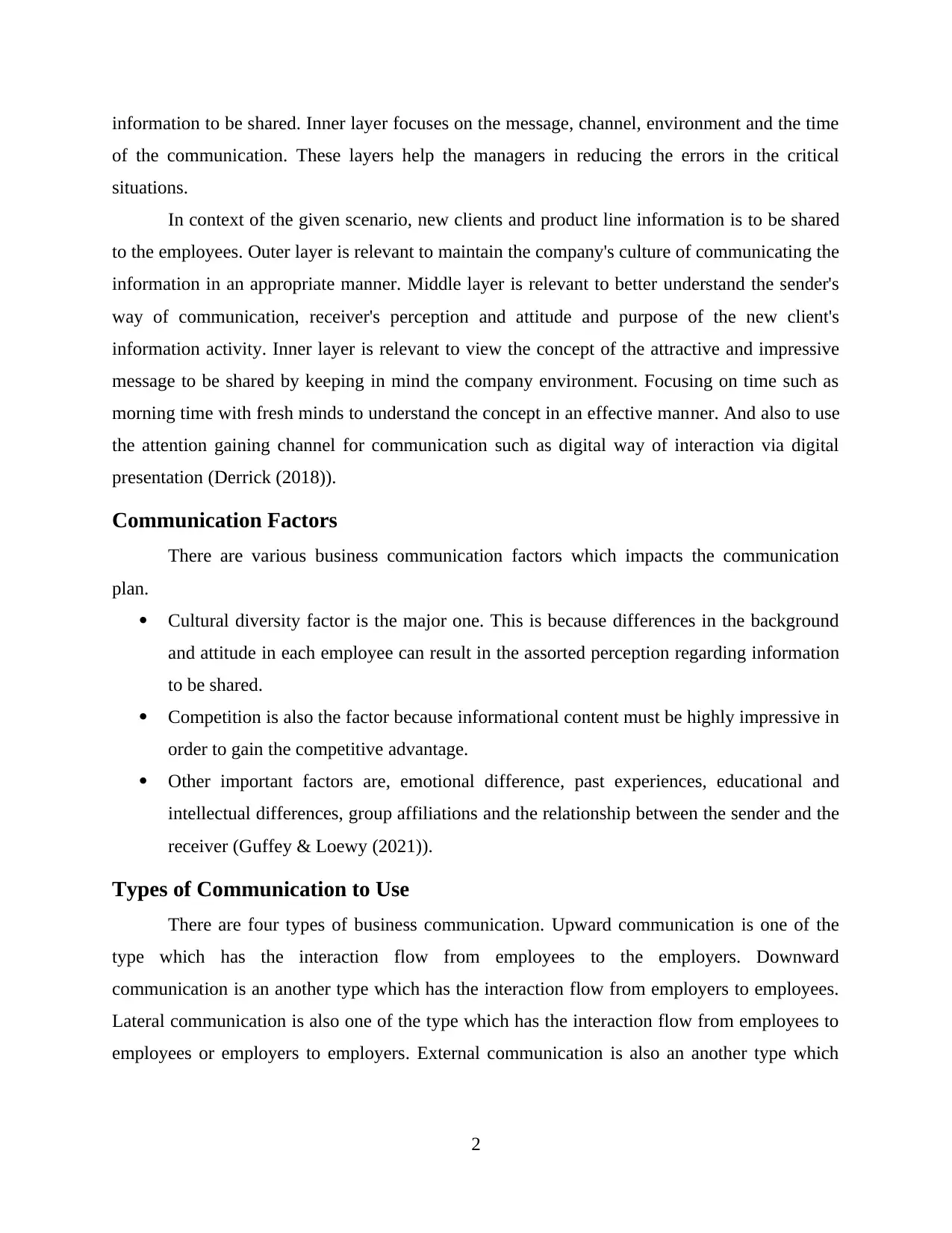
information to be shared. Inner layer focuses on the message, channel, environment and the time
of the communication. These layers help the managers in reducing the errors in the critical
situations.
In context of the given scenario, new clients and product line information is to be shared
to the employees. Outer layer is relevant to maintain the company's culture of communicating the
information in an appropriate manner. Middle layer is relevant to better understand the sender's
way of communication, receiver's perception and attitude and purpose of the new client's
information activity. Inner layer is relevant to view the concept of the attractive and impressive
message to be shared by keeping in mind the company environment. Focusing on time such as
morning time with fresh minds to understand the concept in an effective manner. And also to use
the attention gaining channel for communication such as digital way of interaction via digital
presentation (Derrick (2018)).
Communication Factors
There are various business communication factors which impacts the communication
plan.
Cultural diversity factor is the major one. This is because differences in the background
and attitude in each employee can result in the assorted perception regarding information
to be shared.
Competition is also the factor because informational content must be highly impressive in
order to gain the competitive advantage.
Other important factors are, emotional difference, past experiences, educational and
intellectual differences, group affiliations and the relationship between the sender and the
receiver (Guffey & Loewy (2021)).
Types of Communication to Use
There are four types of business communication. Upward communication is one of the
type which has the interaction flow from employees to the employers. Downward
communication is an another type which has the interaction flow from employers to employees.
Lateral communication is also one of the type which has the interaction flow from employees to
employees or employers to employers. External communication is also an another type which
2
of the communication. These layers help the managers in reducing the errors in the critical
situations.
In context of the given scenario, new clients and product line information is to be shared
to the employees. Outer layer is relevant to maintain the company's culture of communicating the
information in an appropriate manner. Middle layer is relevant to better understand the sender's
way of communication, receiver's perception and attitude and purpose of the new client's
information activity. Inner layer is relevant to view the concept of the attractive and impressive
message to be shared by keeping in mind the company environment. Focusing on time such as
morning time with fresh minds to understand the concept in an effective manner. And also to use
the attention gaining channel for communication such as digital way of interaction via digital
presentation (Derrick (2018)).
Communication Factors
There are various business communication factors which impacts the communication
plan.
Cultural diversity factor is the major one. This is because differences in the background
and attitude in each employee can result in the assorted perception regarding information
to be shared.
Competition is also the factor because informational content must be highly impressive in
order to gain the competitive advantage.
Other important factors are, emotional difference, past experiences, educational and
intellectual differences, group affiliations and the relationship between the sender and the
receiver (Guffey & Loewy (2021)).
Types of Communication to Use
There are four types of business communication. Upward communication is one of the
type which has the interaction flow from employees to the employers. Downward
communication is an another type which has the interaction flow from employers to employees.
Lateral communication is also one of the type which has the interaction flow from employees to
employees or employers to employers. External communication is also an another type which
2
Paraphrase This Document
Need a fresh take? Get an instant paraphrase of this document with our AI Paraphraser
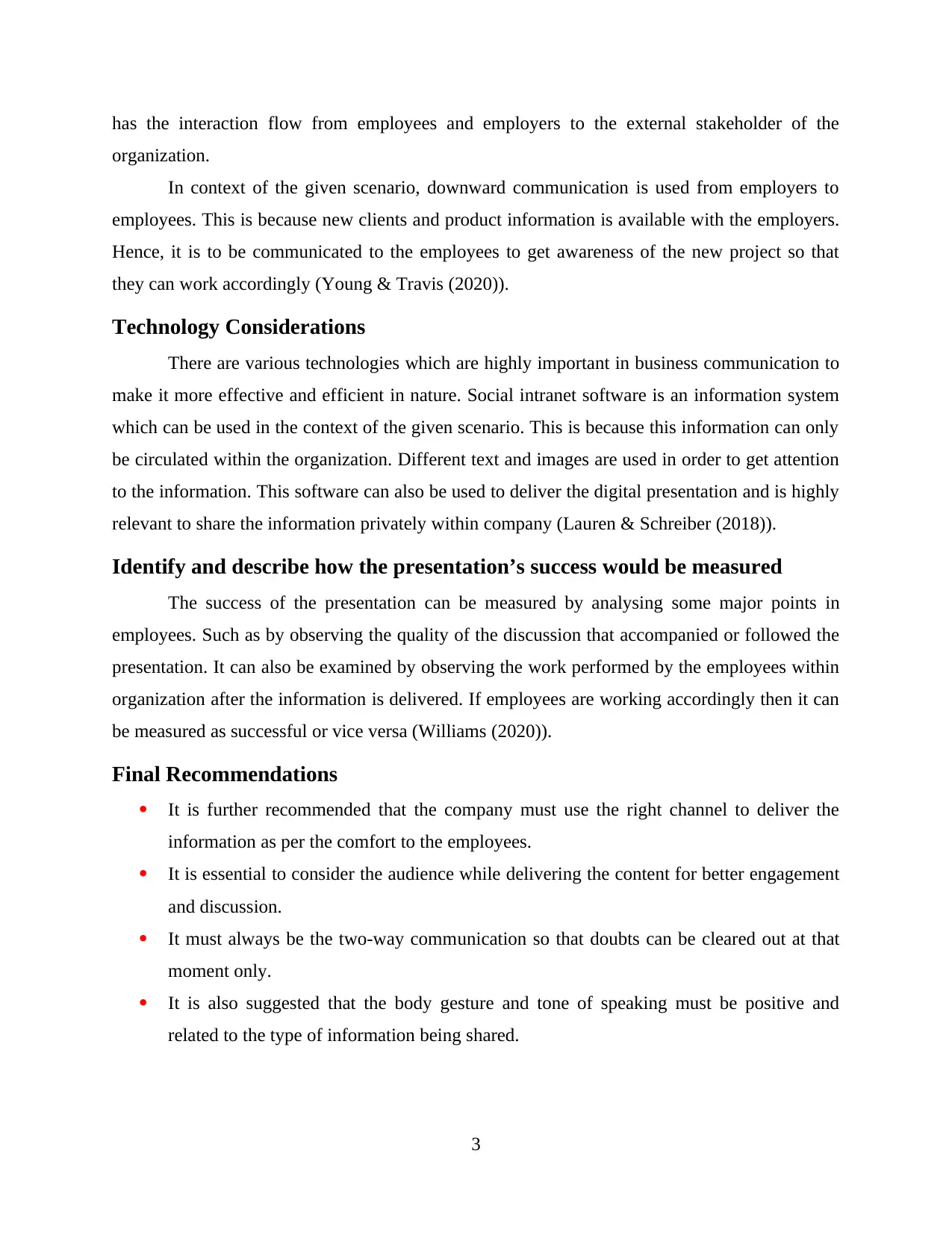
has the interaction flow from employees and employers to the external stakeholder of the
organization.
In context of the given scenario, downward communication is used from employers to
employees. This is because new clients and product information is available with the employers.
Hence, it is to be communicated to the employees to get awareness of the new project so that
they can work accordingly (Young & Travis (2020)).
Technology Considerations
There are various technologies which are highly important in business communication to
make it more effective and efficient in nature. Social intranet software is an information system
which can be used in the context of the given scenario. This is because this information can only
be circulated within the organization. Different text and images are used in order to get attention
to the information. This software can also be used to deliver the digital presentation and is highly
relevant to share the information privately within company (Lauren & Schreiber (2018)).
Identify and describe how the presentation’s success would be measured
The success of the presentation can be measured by analysing some major points in
employees. Such as by observing the quality of the discussion that accompanied or followed the
presentation. It can also be examined by observing the work performed by the employees within
organization after the information is delivered. If employees are working accordingly then it can
be measured as successful or vice versa (Williams (2020)).
Final Recommendations
It is further recommended that the company must use the right channel to deliver the
information as per the comfort to the employees.
It is essential to consider the audience while delivering the content for better engagement
and discussion.
It must always be the two-way communication so that doubts can be cleared out at that
moment only.
It is also suggested that the body gesture and tone of speaking must be positive and
related to the type of information being shared.
3
organization.
In context of the given scenario, downward communication is used from employers to
employees. This is because new clients and product information is available with the employers.
Hence, it is to be communicated to the employees to get awareness of the new project so that
they can work accordingly (Young & Travis (2020)).
Technology Considerations
There are various technologies which are highly important in business communication to
make it more effective and efficient in nature. Social intranet software is an information system
which can be used in the context of the given scenario. This is because this information can only
be circulated within the organization. Different text and images are used in order to get attention
to the information. This software can also be used to deliver the digital presentation and is highly
relevant to share the information privately within company (Lauren & Schreiber (2018)).
Identify and describe how the presentation’s success would be measured
The success of the presentation can be measured by analysing some major points in
employees. Such as by observing the quality of the discussion that accompanied or followed the
presentation. It can also be examined by observing the work performed by the employees within
organization after the information is delivered. If employees are working accordingly then it can
be measured as successful or vice versa (Williams (2020)).
Final Recommendations
It is further recommended that the company must use the right channel to deliver the
information as per the comfort to the employees.
It is essential to consider the audience while delivering the content for better engagement
and discussion.
It must always be the two-way communication so that doubts can be cleared out at that
moment only.
It is also suggested that the body gesture and tone of speaking must be positive and
related to the type of information being shared.
3
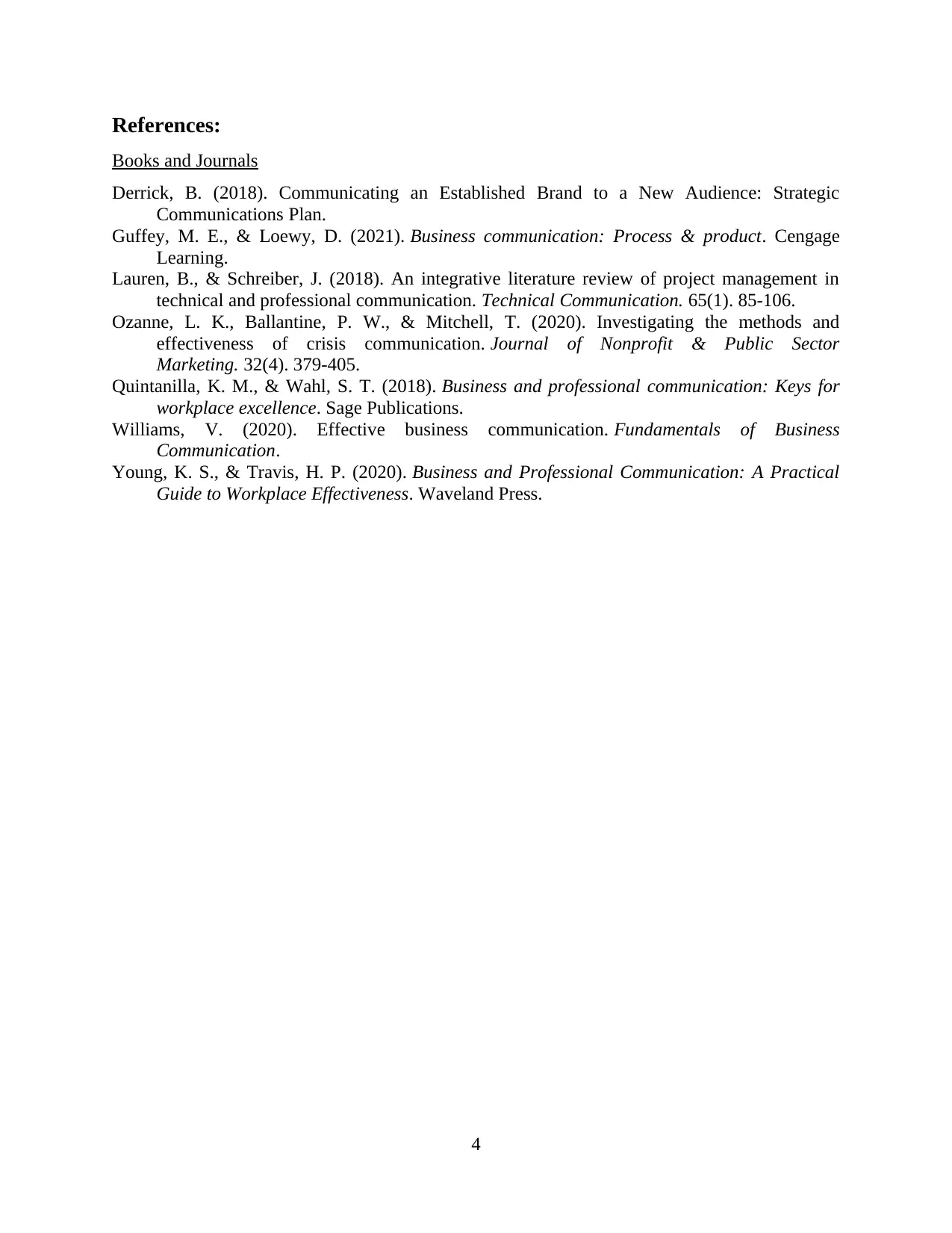
References:
Books and Journals
Derrick, B. (2018). Communicating an Established Brand to a New Audience: Strategic
Communications Plan.
Guffey, M. E., & Loewy, D. (2021). Business communication: Process & product. Cengage
Learning.
Lauren, B., & Schreiber, J. (2018). An integrative literature review of project management in
technical and professional communication. Technical Communication. 65(1). 85-106.
Ozanne, L. K., Ballantine, P. W., & Mitchell, T. (2020). Investigating the methods and
effectiveness of crisis communication. Journal of Nonprofit & Public Sector
Marketing. 32(4). 379-405.
Quintanilla, K. M., & Wahl, S. T. (2018). Business and professional communication: Keys for
workplace excellence. Sage Publications.
Williams, V. (2020). Effective business communication. Fundamentals of Business
Communication.
Young, K. S., & Travis, H. P. (2020). Business and Professional Communication: A Practical
Guide to Workplace Effectiveness. Waveland Press.
4
Books and Journals
Derrick, B. (2018). Communicating an Established Brand to a New Audience: Strategic
Communications Plan.
Guffey, M. E., & Loewy, D. (2021). Business communication: Process & product. Cengage
Learning.
Lauren, B., & Schreiber, J. (2018). An integrative literature review of project management in
technical and professional communication. Technical Communication. 65(1). 85-106.
Ozanne, L. K., Ballantine, P. W., & Mitchell, T. (2020). Investigating the methods and
effectiveness of crisis communication. Journal of Nonprofit & Public Sector
Marketing. 32(4). 379-405.
Quintanilla, K. M., & Wahl, S. T. (2018). Business and professional communication: Keys for
workplace excellence. Sage Publications.
Williams, V. (2020). Effective business communication. Fundamentals of Business
Communication.
Young, K. S., & Travis, H. P. (2020). Business and Professional Communication: A Practical
Guide to Workplace Effectiveness. Waveland Press.
4
⊘ This is a preview!⊘
Do you want full access?
Subscribe today to unlock all pages.

Trusted by 1+ million students worldwide
1 out of 6
Related Documents
Your All-in-One AI-Powered Toolkit for Academic Success.
+13062052269
info@desklib.com
Available 24*7 on WhatsApp / Email
![[object Object]](/_next/static/media/star-bottom.7253800d.svg)
Unlock your academic potential
Copyright © 2020–2025 A2Z Services. All Rights Reserved. Developed and managed by ZUCOL.




